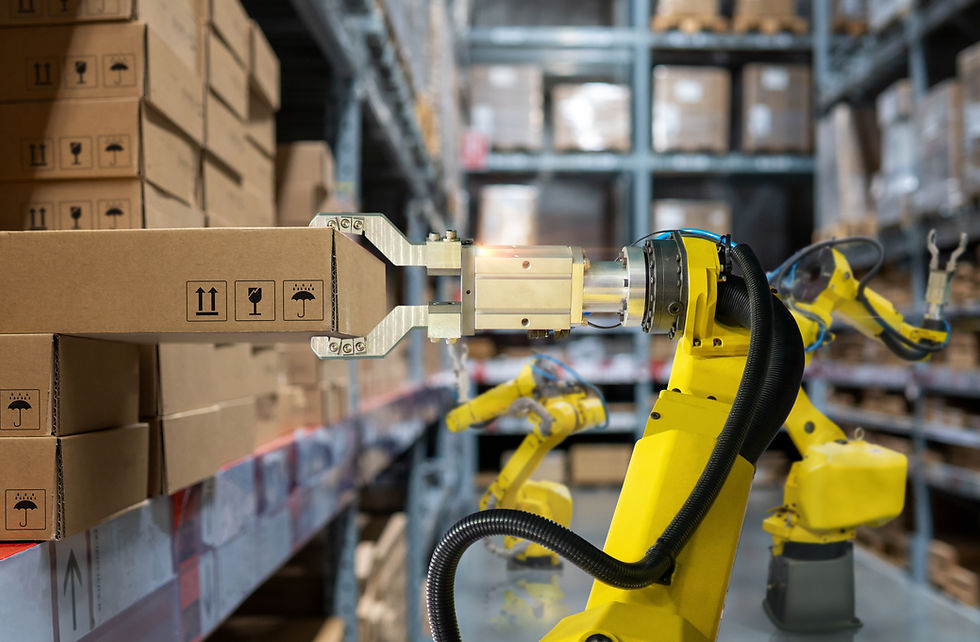Top Warehouse Automation Robots and Their Real-World Applications
- Blue Sky Robotics

- 3 days ago
- 3 min read
Updated: 2 days ago
Gone are the days when a warehouse robot simply meant a machine that moved pallets from point A to B. In 2025, robotics in the warehouse is all about intelligence, precision, and adaptability. Whether you’re in e-commerce, B2B distribution, or industrial supply chains, the new generation of warehouse robots is built to handle high-mix, high-speed environments with finesse.
In this guide, we break down the most common types of warehouse robots, real-world use cases, and how to evaluate them based on capabilities, ROI, and application fit.
Warehouse Robotics in 2025: Smarter Systems, Better Results
The rise of AI, machine vision, and modular automation has transformed the robotics warehouse from a novelty into a necessity. Today’s robots are built to collaborate with human workers, navigate dynamic environments, and adapt to shifting inventory and order profiles.
The Main Categories of Warehouse Robots
1. Autonomous Mobile Robots (AMRs)
These self-navigating robots transport goods within the warehouse using sensors, SLAM (simultaneous localization and mapping), and AI. Unlike AGVs, they don’t require fixed paths.
Use Cases: Goods-to-person picking, replenishment, zone transfers
Industries: E-commerce fulfillment, 3PL, pharma
Notable Feature: Real-time route optimization
2. Robotic Palletizers and Depalletizers
These robots automate the heavy lifting—literally. Equipped with robust end effectors (grippers, suction cups, clamps), they stack and unstack cases and cartons on pallets with precision.
Use Cases: Shipping, receiving, bulk storage
Industries: Food & beverage, manufacturing, retail distribution
ROI Outlook: Often pays off in 12–18 months via labor savings and throughput gains
3. Pick-and-Place Robots
These robotic arms handle delicate or small-item picking using advanced end effectors and AI-driven vision systems to identify and grasp items from bins or conveyors.
Use Cases: E-commerce picking, kitting, returns processing
Industries: Apparel, electronics, beauty, small parts
Key Capability: Object recognition + adaptive gripping
Real-World Use Cases
E-commerce: AMRs reduce walk time for pickers by 60%, speeding up same-day shipping.
Industrial Distribution: Robotic palletizers run 24/7, increasing dock productivity.
B2B Wholesale: Pick-and-place bots manage high SKU diversity in tight spaces.
Choosing the Right Warehouse Robot: A Fit-First Approach
When evaluating a robot, it’s not just about tech specs—it’s about fit.
Ask Yourself:
What tasks drain the most labor hours?
How variable are your SKUs (size, weight, fragility)?
What’s your peak throughput requirement?
Do you need fixed or mobile systems?
Pro tip: The end effector is often the most important component. Choose grippers or tools that match your item type—vacuum for polybags, fingers for electronics, clamps for heavy cartons.

Evaluating ROI and Performance
Modern warehouse robots often deliver ROI within 12–24 months, depending on:
Labor displacement or augmentation
Increased order accuracy
Reduced cycle times
Better space utilization
Use simulation software or digital twins to model impact before deployment. Look for vendors offering pilot programs or performance-based contracts.
What Capabilities Matter Most in 2025?
When comparing solutions, prioritize:
AI + Machine Vision: For object recognition and SKU variability
Fleet Management: To coordinate multiple bots at once
Integration Readiness: With your WMS, ERP, or order management platform
Modularity: Can you expand as your needs grow?
Final Thoughts
The modern warehouse robot is no longer just about lifting and moving. It’s about adapting, learning, and optimizing every movement in your facility. Whether you’re looking to eliminate manual palletizing, reduce picking time, or increase overall throughput, there’s a robot built for your goals.
By understanding the different types of robotic systems—and the capabilities of their end effectors—you’ll be better equipped to build a smarter, leaner, and more scalable robotics warehouse operation.
Get in touch with Blue Sky Robotics today and see what robotics can do for your warehouse.


